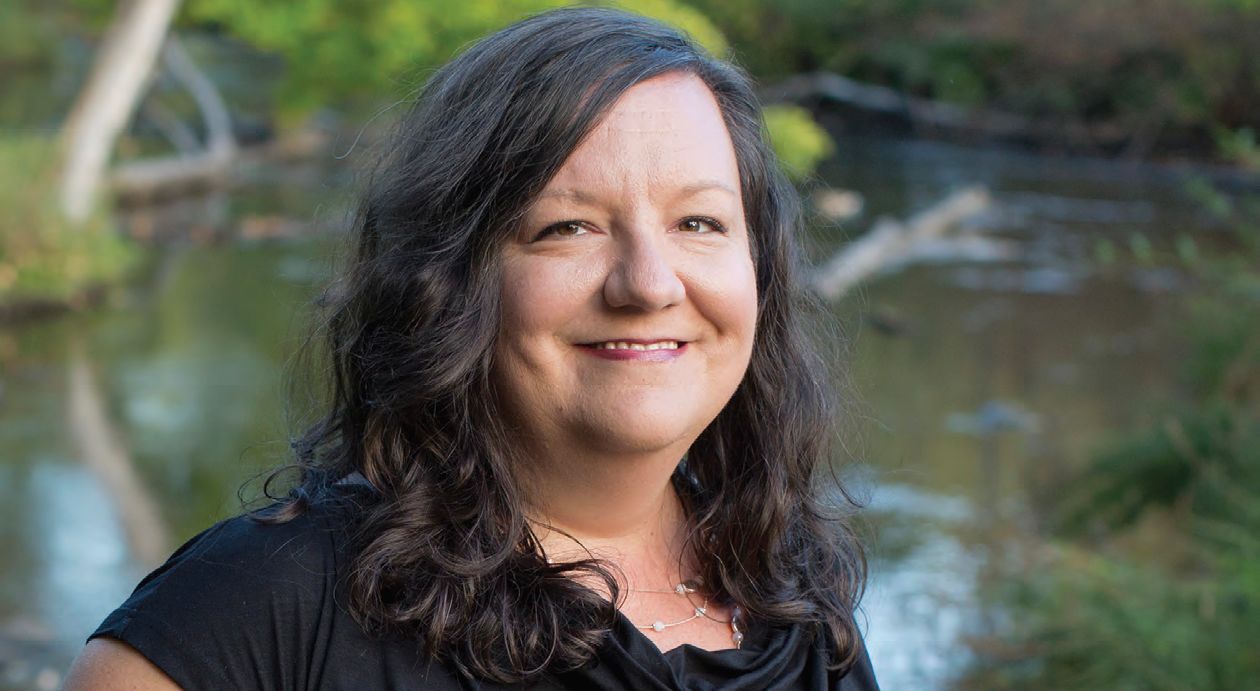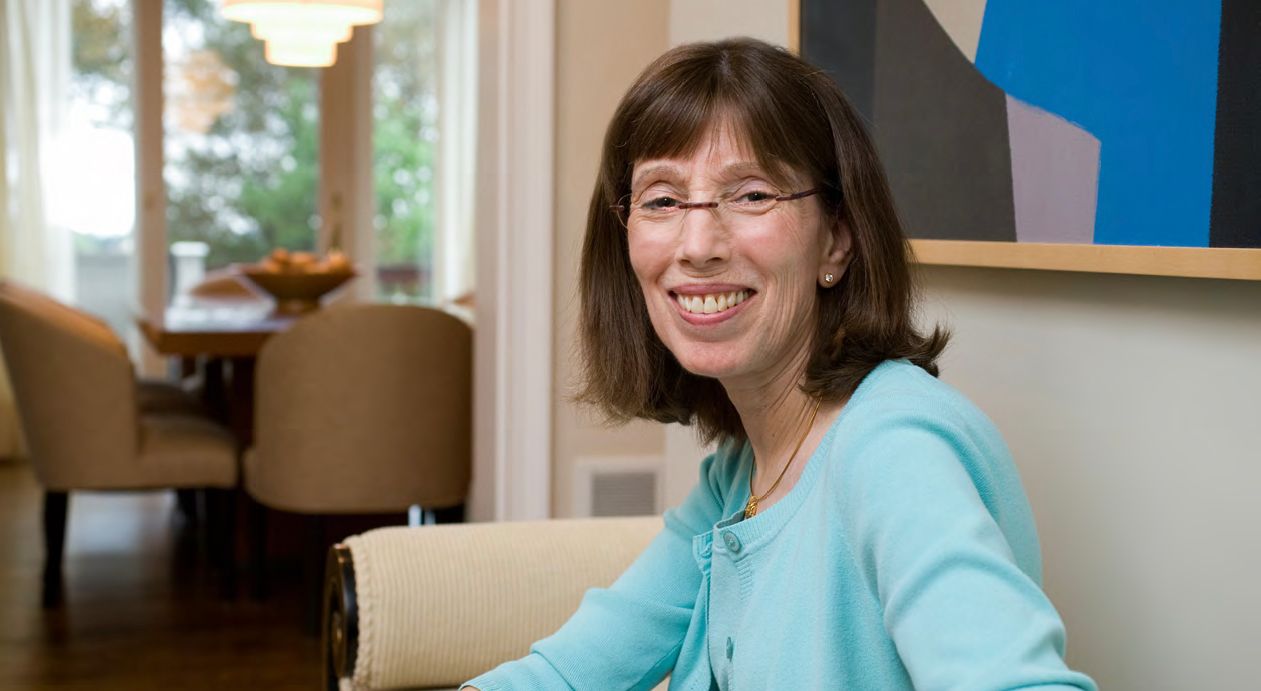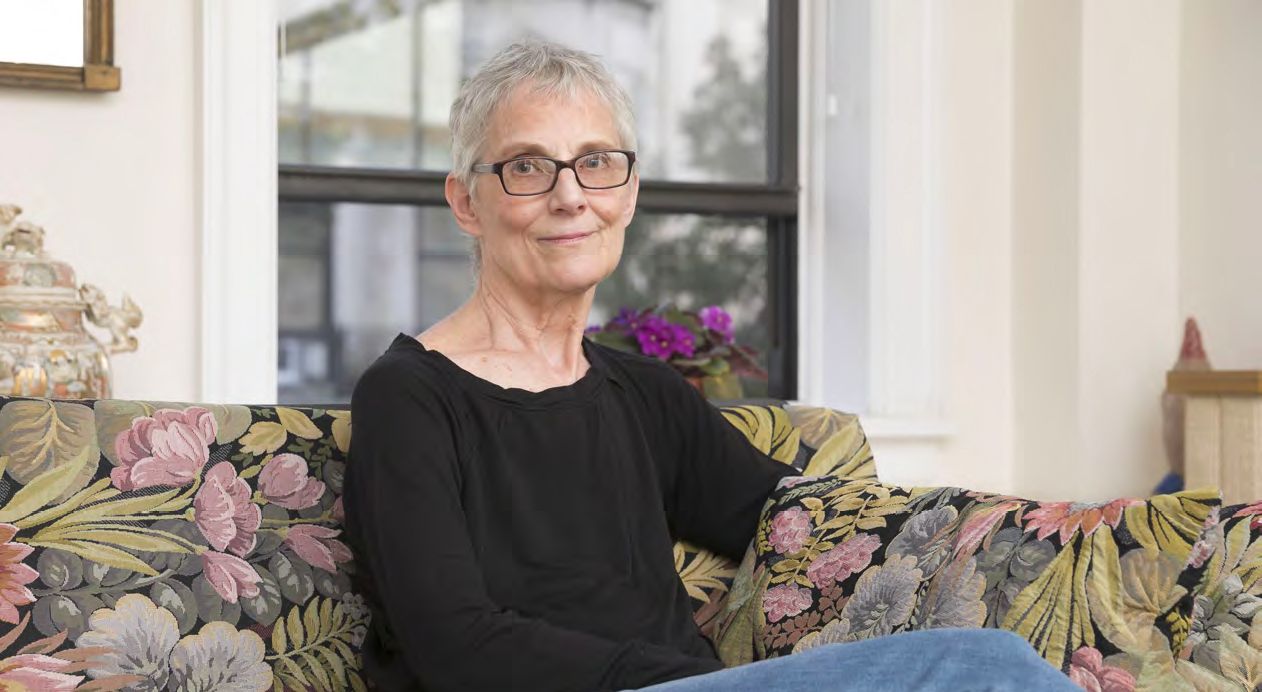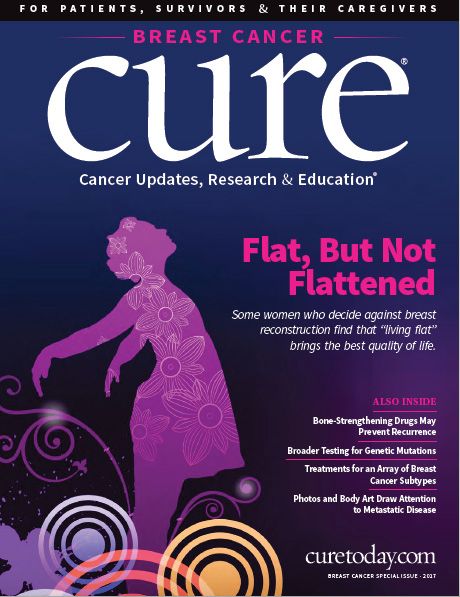Publication
Article
CURE
Reconstruction Decisions: "Living Flat" After Breast Cancer
Author(s):
Women aren’t always advised that they can opt against breast reconstruction after mastectomy, yet for some, “living flat” brings the best quality of life.
SARA BARTOSIEWICZ-HAMILTON, after finding she was more comfortable without reconstructed breasts after mastectomy, founded the group Flat & Fabulous to help support others choosing to live flat. - PHOTO BY MARK BUGNASKI

SARA BARTOSIEWICZ-HAMILTON, after finding she was more comfortable without reconstructed breasts after mastectomy, founded the group Flat & Fabulous to help support others choosing to live flat. - PHOTO BY MARK BUGNASKI
When Sara Bartosiewicz-Hamilton tested positive for the BRCA2 mutation at the age of 29, nothing could have prepared her for what the next few years would bring.
“I was scared out of my mind,” she says. “But I knew, when I submitted my blood for the test, that if I had the mutation, I was going to have a mastectomy.” According to the National Cancer Institute, a prophylactic mastectomy can reduce the risk of developing breast cancer in a woman with a BRCA gene mutation by 95 percent. For Hamilton, the decision to get the surgery was a no-brainer — as was the choice to go through reconstruction afterward.
“My plastic surgeon never talked to me about not going through reconstruction,” she says. “I kind of just presented myself to him and was agreeable to whatever he thought was best.”
Studies show that this experience is common: The American Society of Plastic Surgeons found that, before going through mastectomy, more than 70 percent of women aren’t fully informed of reconstructive options. Even more startling, many patients report that their doctors urged them to undergo reconstruction, making it feel like their only option. It’s a decision faced by all women who undergo mastectomy, whether the surgery is a prophylactice measure due to breast cancer risk or part of treatment for the disease.
Deanna Attai, M.D., an assistant clinical professor of surgery at the David Geffen School of Medicine at UCLA, recalls a former patient who was choosing to undergo a prophylactic bilateral mastectomy due to a BRCA mutation. “She did not want reconstruction, but the first surgeon she saw wouldn’t do the mastectomy until she saw a psychiatrist,” Attai says. “She was a very educated woman, had clearly researched her options (and) she had known about her BRCA mutation (for years). She had thought about this for a long, long time. So, I think, sometimes, patients feel like they aren’t even allowed the option of not doing reconstruction.”
Following her mastectomy, Bartosiewicz-Hamilton underwent a series of surgeries to reconstruct her breasts. However, in the years that followed, she developed issues in her chest, which eventually culminated in a sensation she describes as an “electric shock” that never went away.
“I felt like my chest was on fire all day, every day,” she says. “I had gone through so much to have reconstruction … and I just wanted to be done with it.”
A SWINGING PENDULUM
At age 34, Bartosiewicz-Hamilton had her breasts removed for the second time, and she finally began to embrace a lifestyle that many women have come to identify with post-mastectomy. She began to live life flat.
When it comes to reconstruction post-mastectomy, many describe the issue as a pendulum, a topic that oscillates between two extremes.
“When I first started in practice, getting reconstruction meant that your only option was a silicone implant … and most people didn’t do it. But as there were better options, women started feeling some pressure,” says Susan Love, M.D., M.B.A., chief visionary officer at Dr. Susan Love Research Foundation, an organization dedicated to mobilizing a future without breast cancer by igniting forward-thinking, collaborative research and a distinctive approach to education.
In 1998, only 15 percent of women opted for reconstruction within four months after mastectomy; in 2014, that number rose to 41 percent among women who underwent mastectomy and remained disease-free over a longer follow-up period.
“I think there was an assumption by mostly male surgeons at that time that women would absolutely want this … Coming from their vantage point, that seemed normal,” Love says. “But the trouble with reconstruction is that it doesn’t look normal and it doesn’t feel normal — maybe to them it does, but not to you.”
Within two months of having her implants removed, Bartosiewicz-Hamilton created an advocacy group called Flat & Fabulous, a space that seeks to “support and empower women to embrace life without reconstruction after mastectomy.”
“When I first founded Flat & Fabulous, women came to me all the time and said: ‘I thought I was the only person,’” she says. “There are women out there who don’t want to go through the pain and danger of reconstructive surgery, and that’s a valid choice.”
A year before Bartosiewicz-Hamilton received her diagnosis, Barbara Kriss went through a similar struggle. After being diagnosed with breast cancer for the second time at age 57, Kriss was advised to have a bilateral mastectomy. In 2007, she started BreastFree.org, which she believes is “the first website dedicated to offering information and support to women considering opting against reconstruction.”
“For some women, reconstruction is the right thing,” Kriss says. “But then there are others, like me, who really feel like they don’t need it.”
A PROCESS, NOT A PROCEDURE
Now, with the help of advocacy groups such as these raising awareness and support for women who choose to go flat, the pendulum seems to be swinging back, settling somewhere in that middle space where women feel empowered to make their own decisions.
Bartosiewicz-Hamilton’s lengthy and painful experience with reconstruction is more common than many realize. The risk of complication after reconstruction following a double mastectomy can be as high as 40 percent, according to Attai.
“Reconstruction is a process, not a procedure,” she says. “The more surgery we do, the higher the complication rate.”
BARBARA KRISS'S website, breastfree.org, helps women consider whether going flat after mastectomy is right for them. - PHOTO BY LEISE JONES

BARBARA KRISS'S website, breastfree.org, helps women consider whether going flat after mastectomy is right for them. - PHOTO BY LEISE JONES
Immediate complications from reconstruction may include bleeding, infection, fluid under the wound or flap or nipple necrosis, in which the nipple or flap of tissue used to make the new breast dies. Longer-term complications may include risks involving anesthesia; loss, hardening or changing shape of the implant; leakage of the implant fluid; abdominal hernias; “dog ears,” small folds of skin and fat that can develop at either end of the abdominal scar; or even chronic pain that affects other organs.
There is also the risk of unplanned additional surgeries. A 2015 study involving the impact of reconstruction and reoperation on long-term patient satisfaction reported that, although 83 percent of women responded that they were happy with their contralateral prophylactic mastectomy and would choose it again, immediate reconstruction patients demonstrated “significantly lower satisfaction and were less likely to choose CPM again.” Although 73 percent of the women overall said they would make the same choice again regarding reconstruction, among those who underwent that surgery, 39 percent needed one or more unplanned reoperations. That was “strongly associated with lower satisfaction, lower likelihood of choosing CPM again and lower likelihood of choosing reconstruction again,” the study authors said.
For many women, after the trauma of being diagnosed with cancer, undergoing treatment and facing the reality of a mastectomy, the thought of even more surgery with so many possible risks is just too much to bear.
“When you have cancer, it’s already so overwhelming (that) sometimes the last thing you want to do is make more decisions,” Love says. “But the great thing is, you don’t have to. You can actually take care of the breast cancer, and then, at your leisure, figure out what you want to do.”
Women who are undecided about reconstruction can delay the procedure for six to 12 months or more after mastectomy. This operation is usually accomplished by transferring some of the woman’s own tissue, often from her abdomen, to the breast area, rather than using implants. Possible complications are similar to those associated with immediate reconstruction but occur less often, and the delay in surgery results in a shorter procedure and generally faster healing.
“Initially, I assumed I’d have reconstruction,” says Megan Rutherford, who was diagnosed with stage 2 breast cancer in 2005. She describes her treatment as “long and arduous,” involving radiation and a three-drug chemotherapy regimen that included Adriamycin (doxorubicin), a drug known in the cancer community as “the red devil” because of its harsh side effects. Rutherford originally made an appointment for reconstruction, but ultimately decided to cancel after learning that her radiation excluded her from implants and that a deep inferior epigastric artery perforator (DIEP) flap, in which tissue would be moved from her abdomen to her chest, was “a lot of risk for a minimal effect."
MEGAN RUTHERFORD decided that breast reconstruction after mastectomy was not worth the effort and risk. - PHOTO BY BEN HIDER

MEGAN RUTHERFORD decided that breast reconstruction after mastectomy was not worth the effort and risk. - PHOTO BY BEN HIDER
“By the time I was done with everything, I was just ready to move on,” she says. “I really wanted to have a (life after cancer), and I didn’t want to put it off even further … I was just ready to be a regular person again.”
After experiencing life both with and without construction, Bartosiewicz-Hamilton learned that, while she initially thought she needed breasts to feel like herself, that was not true.
NOTHING WORKS FOR EVERYBODY
“As women, we’re self-conscious because we know we’re missing the part that society says makes us a woman,” she says. “But, eventually, I just embraced that this was me … My implants had never felt like a part of me. I had never embraced them; I never liked them; they just didn’t feel right. When I had them removed, I just felt like myself again.”
Although women choose to live life flat for numerous reasons, both surgeons and survivors agree on this: Nothing works for everybody.
“I think it’s really good that women have the option to go flat or to have reconstruction,” says Clara Lee, M.D., a plastic and reconstructive surgeon at Ohio State University Wexner Medical Center. “But the most important thing is that women should have options.”
Lee encourages women to become as knowledgeable as possible about reconstruction, including the pros and the cons. For example, while reconstruction requires more surgery, and therefore more risk, many women find the outcome more aesthetically pleasing. Choosing to go flat means less surgery and faster healing, but women might want or need to wear special bras, magnets or adhesive patches to hold a prosthesis in place, which can be a hassle and uncomfortable.
After educating themselves on both sides of the argument, women should go through a process of clarifying what matters most to them across a number of areas, Lee says.
“How strongly do you feel about having a breast shape when you’re not wearing clothing?” Lee asks. “How strongly do you feel about the risk of complications, more surgery or a longer recovery time? Ideally, we can connect these personal values to the various pros and cons of the procedures, and that will inform … whether or not reconstruction might be right for you.”
Studies have found that there is no significant difference in the rates of local recurrence, metastasis or survival among women who choose to reconstruct versus those who do not. Furthermore, while developing a new breast cancer after mastectomy is very unlikely, if one did occur, reconstruction would not make it harder to detect, according to the American Cancer Society. Finally, Lee says, a systematic review of mastectomy patients she conducted found that “the majority of measurements of quality of life, body image and sexuality did not find significant differences between mastectomy with reconstruction and mastectomy only.”
The biggest indicator in overall satisfaction among patients is simple: the ability to choose for themselves. “I really felt that this had to be my decision,” Kriss says. “As much as I love my husband and my kids, it really had to be what I felt the most comfortable with. A lot of times, women think about how their spouse will feel, or how they’ll feel in front of their spouse or partner or future boyfriend … but in my own experience, my family’s reaction … was that they just wanted me alive. They couldn’t care less. They just wanted me to do whatever was going to make me feel best.”
Attai says that, in her experience, most women ultimately feel good about their choice. “The majority of patients who have made the decision to not do reconstruction have been very happy with their decision. And the majority of patients who do opt for reconstruction also seem to be happy and comfortable with their decision,” she says. “It’s all about taking the time with our patients to really make sure that they’re getting multiple opinions, seeing more than one plastic surgeon and really thinking through their options.”
“There’s power in choosing something rather than feeling like you don’t have a choice,” Bartosiewicz- Hamilton says. “This is not about changing people’s minds. It’s about letting women empower themselves to make the choice that’s right for them.”





